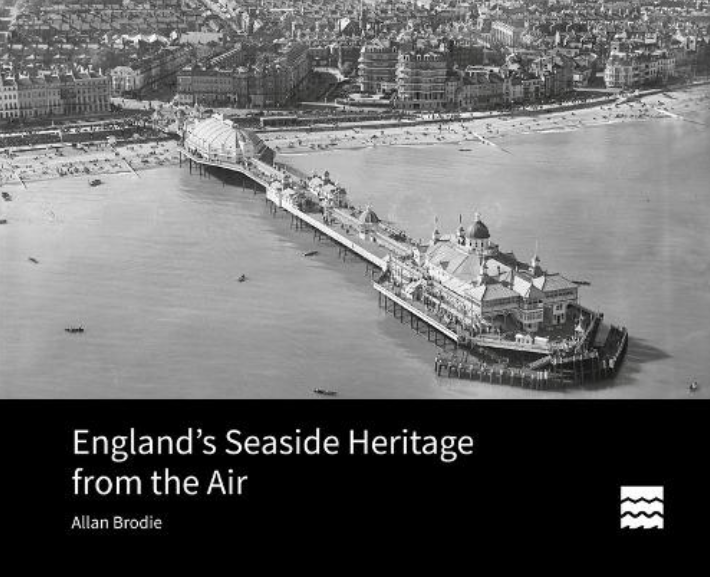England's Seaside Heritage from the Air

|
| England’s Seaside Heritage from the Air, Allan Brodie, Liverpool University Press/ Historic England, 2021, 299 pages, 150 black-and-white illustrations, hardback. |
The economic fortunes of the UK’s seaside towns have ebbed and flowed. Under the current effects of Covid-19, a revival may be in progress at a time when foreign travel is difficult or even impossible for most sun-seekers. Since around 2000 the towns themselves have certainly been actively trying to improve their offering, including adding new attractions and upgrading services to match those abroad. My own periodic visits to Margate over many years have demonstrated how the town and its amenities are currently on an up-swing of remarkable force. Awareness of heritage plays an important part in this evolution.
The latest addition to the series of Historic England’s volumes based on the archives of Aerofilms, which they acquired in 2007, takes us back to an earlier but vital phase of seaside history. We see numerous examples of English coastal towns where holiday tourism led to a series of characteristic architectural forms when the railway era impacted on existing small ports or old waterside spas. As the 20th century progressed and annual holidays for workers topped-up on day-trip visits to the coast, there was a massive expansion, with its own architectural legacy. Holiday camps appeared and estates of bungalows were built next to the sea.
By the time the second world war brought this era to a close, private car ownership had begun to have an impact. Photography from the air re-adopted for a few years its wartime role of target identification, for which it had first been employed in the ‘Great War’. In 1946, with a further boom in peacetime, a caravan park had even appeared near Blackpool.
Alan Brodie is a recognised scholar of the seaside and its architecture, both in UK and abroad. In his text and well-laid-out, full-page black-and-white images he takes us on a journey in words and photos from 1920 to 1953, when holidays by the sea were at their peak. The current volume takes its place alongside earlier books on motoring and railways, all of which have been reviewed in IHBC’s Context, and their titles and much else about surveys from the air may be found on Historic England websites.
The seaside book will appeal to students of urban form and lovers of grand Edwardian hotels and the superb piers that stand (or stood) near them, as well as to collectors of illustrated books on architecture and fans of aerial photography. It also provides valuable evidence about sites and structures whose plans might appear on the Ordnance Survey but whose elevations, roof forms and surroundings such as gardens can be more fully appreciated from the air. These same air-shots demonstrate vividly how urban development has been governed by rocks, cliffs, estuaries or flat marshland at the places where the land meets the sea.
The volume contains a short but useful list of books, including those on individual resorts (such as Blackpool and Weymouth) as an aid to compiling statements and appraisals for districts or surviving un-listed heritage. The victims of the bad times, no longer existing, are also recorded here from their inter-war heyday.
This article originally appeared as ‘Looking back and down’ in the Institute of Historic Building Conservation’s (IHBC’s) Context 171, published in March 2022. It was written by Graham Tite, gardener, cook and essayist.
--Institute of Historic Building Conservation
Related articles on Designing Buildings
IHBC NewsBlog
Southend Council pledge to force Kursaal owners to maintain building
The Council has pledged to use ‘every tool in the toolbox’ if urgent repairs are not carried out.
HE’s Research Magazine publishes a major study of the heritage of England’s suburbs
The article traces the long evolution of an internal programme to research 200 years of suburban growth
IHBC Context 183 Wellbeing and Heritage published
The issue explores issues at the intersection of heritage and wellbeing.
SAVE celebrates 50 years of campaigning 1975-2025
SAVE Britain’s Heritage has announced events across the country to celebrate bringing new life to remarkable buildings.
IHBC Annual School 2025 - Shrewsbury 12-14 June
Themed Heritage in Context – Value: Plan: Change, join in-person or online.
200th Anniversary Celebration of the Modern Railway Planned
The Stockton & Darlington Railway opened on September 27, 1825.
Competence Framework Launched for Sustainability in the Built Environment
The Construction Industry Council (CIC) and the Edge have jointly published the framework.
Historic England Launches Wellbeing Strategy for Heritage
Whether through visiting, volunteering, learning or creative practice, engaging with heritage can strengthen confidence, resilience, hope and social connections.
National Trust for Canada’s Review of 2024
Great Saves & Worst Losses Highlighted
IHBC's SelfStarter Website Undergoes Refresh
New updates and resources for emerging conservation professionals.
















